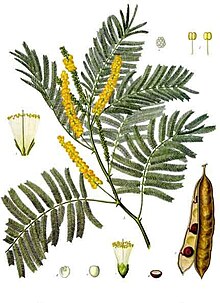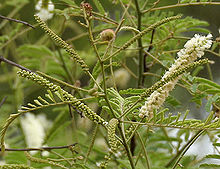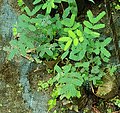Senegalia catechu
| Senegalia catechu | |
|---|---|

| |
| Scientific classification | |
| Kingdom: | Plantae |
| Clade: | Tracheophytes |
| Clade: | Angiosperms |
| Clade: | Eudicots |
| Clade: | Rosids |
| Order: | Fabales |
| Family: | Fabaceae |
| Subfamily: | Caesalpinioideae |
| Clade: | Mimosoid clade |
| Genus: | Senegalia |
| Species: | S. catechu
|
| Binomial name | |
| Senegalia catechu (L.f.) P.J.H.Hurter & Mabb.
| |
| Varieties | |
| |

| |
| Range ofSenegalia catechu | |
| Synonyms[3] | |

Senegalia catechu,previously known asAcacia catechu,is a deciduous, thorny tree which grows up to 15 m (50 ft) in height.[4]The plant is calledkhair[5]in Hindi, andkachuin Malay; the Malay name was Latinized to "catechu" inLinnaean taxonomy,as the species from which the extractscutchandcatechuare derived.[6]Other common names for it includekher,[7]catechu,cachou,cutchtree,black cutch,andblack catechu.
Senegalia catechuis native toSouth AsiaandSoutheast Asia,including the Indian subcontinent, Myanmar, Cambodia and China (Yunnan).[1]

Through derivatives of theflavanolsin its extracts, the species has lent its name to the importantcatechins,catecholsandcatecholaminesof chemistry and biology.
Uses
[edit]Food
[edit]
The tree's seeds are a good source ofprotein.[8]Kattha (catechu), an extract of its heartwood, gives a characteristic flavor and red color topaan,a traditional Indian and Southeast Asian method for chewingbetelleaf (Piper betle) witharecanut and slaked lime paste.
Fodder
[edit]Branches of the tree are quite often cut forgoatfodderand are sometimes fed tocattle.[3][8][9]
Folk medicine
[edit]Theheartwood,bark, and woodextract(calledcatechu) are used intraditional medicine.[4][10]The concentrated aqueous extract, known as khayer gum or cutch, isastringent.[11]
Wood
[edit]
The tree is often planted for use asfirewoodand charcoal and its wood is highly valued for furniture and tools.[4]The wood has a density of about 0.88 g/cm3.[12]
Other uses
[edit]Itsheartwoodextractis used indyeingandleathertanning,as apreservativeforfishing nets,and as aviscosityregulator foroil drilling.[4]Its flowers are a good source of nectar and pollen for bees.
Cultivation
[edit]
The tree can be propagated by planting its seeds, which are soaked in hot water first. After about six months in a nursery, the seedlings can be planted in the field.[4]
-
Plantlings
-
Senegalia catechuplantlings
See also
[edit]References
[edit]- ^abPlummer, J. (2021)."Senegalia catechu".IUCN Red List of Threatened Species.2021:e.T169300001A169300339.Retrieved3 May2022.
- ^hear.org
- ^abInternational Legume Database & Information Service (ILDIS)
- ^abcde"fao.org".Archived fromthe originalon 2019-02-10.Retrieved2007-04-19.
- ^haryana-onlineArchived2011-02-03 at theWayback Machine
- ^http:// yourdictionary /catechuDerivation of word from Malay
- ^Ujwala, T. K.; Tomy, Shawn; Celine, Sandra; Chander, J. Sam Johnson Udaya (2015). "A Systematic Review of Some Potential Anti-Diabetic Herbs Used in India Characterized by Its Hypoglycemic Activity".International Journal of Pharmaceutical Sciences and Research.6(12): 4940–4957.ProQuest1747402306.
- ^ab"World AgroForestry Database".Archived fromthe originalon 2007-09-28.Retrieved2007-05-08.
- ^Heuzé V., Tran G., Hassoun P., Lebas F., 2018. Black cutch (Senegalia catechu). Feedipedia, a programme by INRA, CIRAD, AFZ and FAO.https:// feedipedia.org/node/354Last updated on February 9, 2018, 13:20
- ^"Plant Details".envis.frlht.org.Retrieved2014-10-04.
- ^British Pharmacopoeia, Department of Health, British Pharmacopoeia Commission, London. The Stationery Office, (1999)
- ^FAO Appendix 1
External links
[edit] Media related toSenegalia catechuat Wikimedia Commons
Media related toSenegalia catechuat Wikimedia Commons Data related toAcacia catechuat Wikispecies
Data related toAcacia catechuat Wikispecies Media related toSenegalia catechuat Wikimedia Commons
Media related toSenegalia catechuat Wikimedia Commons






